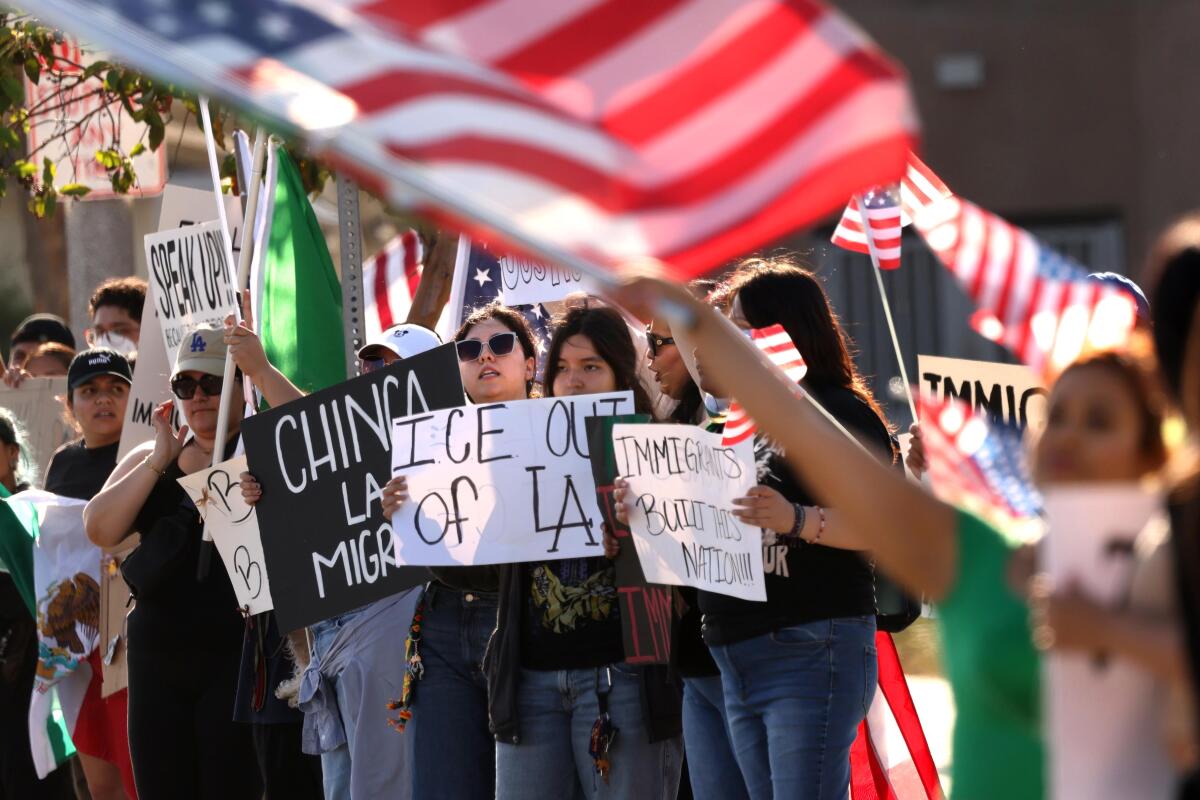Why they protest: Voices from the downtown L.A. ICE demonstrations

- Share via
During a week of protest, Los Angeles is the center stage of the national immigration debate, with pundits on both sides characterizing the fight through the lens of their respective viewpoints.
Not everyone is pleased with the actions — there has been vandalism, destruction and injuries — isolated yet striking moments that have at times overshadowed peaceful demonstrations. But for many out in the demonstrations, there was a message that they wanted to be heard.
During these demonstrations, Los Angeles Times reporters on the ground have interviewed protesters and asked them why they’re demonstrating. Here’s what they had to say:
Downey, known as the ‘Mexican Beverly Hills,’ has been roiled this week by Trump immigration raids roiling Southern California, sparking both fear and outrage.
Alejandra Flores attended a protest in front of Westin LAX Friday with her daughter and her mother, who had recently become a U.S. citizen.
“I have three generations of family here. We came for my family members who can’t come out. We’re able to speak out for them.”
Maritza Perez Huerta attended her first protest this week. She couldn’t make it out to protests a couple of years ago because she was younger and her mother was afraid.
“Now that I’m 23, I want to fight for something that I didn’t fight for before, especially since this is part of me. I’m first gen.”
Priscilla Ramos spent her first day of protesting in front of the Metropolitan Detention Center this week, where Marines were expected to arrive.

“I personally have close friends who have been impacted [by] their fear for their parents’ lives, and they themselves have had to increase the amount of hours that they work just solely so their parents can stay home and not be out in the community ... I’m hear in solidarity with my friends.”
Cynthia Guardano was born in the United States in a mixed-status family. She was downtown demonstrating on Friday.

“My parents are migrants from El Salvador, and so it’s really personal to me, because it’s U.S. imperialism that impacted our community. ... No one chooses to leave their home. No one willingly wants to leave.”
Jason Petty, a 46-year-old musician from Boyle Heights, told The Times he went to a rally because “this is our community — immigration is us.”
Petty, a former ninth-grade history teacher, said he was born and raised in Los Angeles and was here during the 1992 riots. He is Black, and his grandmother lived in Watts during the 1965 Watts riots. His father was a Black Panther.
Petty said he has a daughter in fourth grade and that immigration agents recently came to the neighborhood near her school. He said he has had to have difficult conversations with her, assuring her she’s safe, and why it was important to go to the rally.
“You don’t have to worry about it, but mommy and daddy are sticking up for your friends.”
Outside City Hall in Santa Ana this week, Alicia Rojas observed a protest from afar. The Colombian native had her amnesty application denied as a child. Now a U.S. citizen, Rojas grew up during the era of Proposition 187 and remembered all the racism against people like her at the time.
“I feel rage inside, but this is the healthiest thing to do. More than anything. I’m here to look after the kids.”
On Friday morning, the area around MacArthur Park, a longtime immigrant hub west of downtown, was noticeably quieter than usual. Undocumented immigrants, and even those here legally but fear they could be racially profiled, are exercising extra caution navigating their daily lives.
Michelle Hernandez, 19, marched at the federal building with a Mexican flag draped over her shoulders. A daughter of Mexican immigrants, she said she had been worried about family members and friends during the ICE raids.
“[I want] to be a voice for those who cannot speak.”
Franchesca Olivas drove two hours alone from Hemet to attend the anti-ICE demonstration this week outside the Metropolitan Detention Center in downtown Los Angeles. She was carrying an upside-down American flag attached to the Mexican flag because she’s half-white and half-Mexican.
“I have my American flag upside down because we are in distress. We’re gonna take that flag back.”
Aaron Fontan, 24, said he also has participated in Black Lives Matter protests and felt familiar police pushback and militance this time around. However, he felt that not as many people are willing to show up to anti-ICE protests.
“Being in L.A., where such historical protests have begun, we had the Chicano movement here, the Rodney King riots. That’s what shapes the community, that’s what shapes policies here.”
Beyond the protests, some civic leaders have also voiced their opposition to the escalation in immigration enforcement.
Los Angeles Unified School District Supt. Alberto Carvalho, the son of immigrants, has been outspoken about his mission to protect students:
“I’ve spoken with parents who’ve told me that their daughter would be the first in their family to graduate high school, and they’re not going to be there to witness it, because they have a fear of the place of graduation being targeted. What nation are we becoming?”
Service Employees International Union California President David Huerta was injured and detained while documenting an immigration enforcement raid in downtown L.A. last week.
“This is about how we as a community stand together and resist the injustice that’s happening. Hard-working people, and members of our family and our community, are being treated like criminals. We all collectively have to object to this madness because this is not justice.”
Times staff writers Christopher Buchanan and Annie Goodykoontz contributed to this report.
More to Read
Sign up for Essential California
The most important California stories and recommendations in your inbox every morning.
You may occasionally receive promotional content from the Los Angeles Times.















